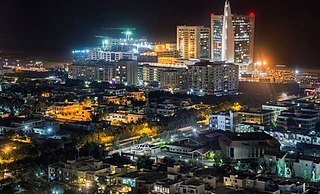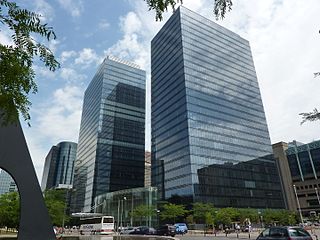Related Research Articles

The economy of Canada is a highly developed market economy. It is the 9th largest GDP by nominal and 15th largest GDP by PPP in the world. As with other developed nations, the country's economy is dominated by the service industry which employs about three quarters of Canadians. Canada has the third highest total estimated value of natural resources, valued at US$33.2 trillion in 2019. It has the world's third largest proven petroleum reserves and is the fourth largest exporter of petroleum. It is also the fourth largest exporter of natural gas. Canada is considered an "energy superpower" due to its abundant natural resources and a small population of 37 million inhabitants relative to its land area.

The economy of Finland is a highly industrialised, mixed economy with a per capita output similar to that of other western European economies such as France, Germany and the United Kingdom. The largest sector of Finland's economy is services at 72.7 percent, followed by manufacturing and refining at 31.4 percent. Primary production is 2.9 percent.

The economy of Grenada is a largely tourism-based, small and open economy. Over the past two decades, the main thrust of Grenada's economy has shifted from agriculture to services, with tourism serving as the leading foreign currency earning sector. The country's principal export crops are the spices nutmeg and mace. Other crops for export include cocoa, citrus fruits, bananas, cloves, and cinnamon. Manufacturing industries in Grenada operate mostly on a small scale, including production of beverages and other foodstuffs, textiles, and the assembly of electronic components for export.

The economy of Nicaragua is focused primarily on the agricultural sector. Nicaragua itself is the least developed country in Central America, and the second poorest in the Americas by nominal GDP. In recent years, under the administrations of Daniel Ortega, the Nicaraguan economy has expanded somewhat, following the global recession of 2009, when the country's economy actually contracted by 1.5%, due to decreased export demand in the US and Central American markets, lower commodity prices for key agricultural exports, and low remittance growth. The economy saw 4.5% growth in 2010 thanks to a recovery in export demand and growth in its tourism industry. Nicaragua's economy continues to post growth, with preliminary indicators showing the Nicaraguan economy growing an additional 5% in 2011. Consumer Price inflation have also curtailed since 2008, when Nicaragua's inflation rate hovered at 19.82%. In 2009 and 2010, the country posted lower inflation rates, 3.68% and 5.45%, respectively. Remittances are a major source of income, equivalent to 15% of the country's GDP, which originate primarily from Costa Rica, the United States, and European Union member states. Approximately one million Nicaraguans contribute to the remittance sector of the economy.

The economy of Pakistan is the 22nd largest in the world in terms of purchasing power parity (PPP), and 45th largest in terms of nominal gross domestic product. Pakistan has a population of over 220 million, giving it a nominal GDP per capita of $1,186 in 2020-21, which ranks 154th in the world and giving it a PPP GDP per capita of $5,839 in 2019, which ranks 132nd in the world for 2019. However, Pakistan's undocumented economy is estimated to be 36% of its overall economy, which is not taken into consideration when calculating per capita income. Pakistan is a developing country. The economy is semi-industrialized, with centres of growth along the Indus River. Primary export commodities include textiles, leather goods, sports goods, chemicals and carpets/rugs.

The economy of Seychelles is based on fishing, tourism, processing of coconuts and vanilla, coir rope, boat building, printing, furniture and beverages. Agricultural products include cinnamon, sweet potatoes, cassava (tapioca), bananas, poultry and tuna.

The economy of Belgium is a modern, capitalist economy that has capitalised on the country's central geographic location, highly developed transport network, and diversified industrial and commercial base. Belgium was the first country to undergo an industrial revolution on the continent of Europe in the early 19th century and has since developed an excellent transportation infrastructure of ports, canals, railways, and highways to integrate its industry with that of its neighbours. Industry is concentrated mainly in the populous Flanders in the north, around Brussels and in the two biggest Walloon cities, Liège and Charleroi, along the sillon industriel. Belgium imports raw materials and semi-finished goods that are further processed and re-exported. Except for its coal, which is no longer economical to exploit, Belgium has few natural resources other than fertile soils. Nonetheless, most traditional industrial sectors are represented in the economy, including steel, textiles, refining, chemicals, food processing, pharmaceuticals, automobiles, electronics, and machinery fabrication. Despite the heavy industrial component, services account for 74.9% of GDP, while agriculture accounts for only 1% of GDP.

The Rust Belt is a region of the Northeastern and Midwestern United States that has been experiencing industrial decline starting around 1980. It is made up largely of the Great Lakes Megalopolis, though definitions vary. Rust refers to the deindustrialization, economic decline, population loss, and urban decay due to the shrinking of its once-powerful industrial sector, such as steel, automobile, and coal mining. The term gained popularity in the U.S. in the 1980s, when it was commonly contrasted with the Sun Belt which was resurging then.

The economy of India is characterised as a middle income developing market economy. It is the world's fifth-largest economy by nominal GDP and the third-largest by purchasing power parity (PPP). According to the International Monetary Fund (IMF), on a per capita income basis, India ranked 142nd by GDP (nominal) and 124th by GDP (PPP) in 2020. From independence in 1947 until 1991, successive governments promoted protectionist economic policies with extensive state intervention and economic regulation, which is characterised as dirigism, in the form of the License Raj. The end of the Cold War and an acute balance of payments crisis in 1991 led to the adoption of a broad economic liberalisation in India. Since the start of the 21st century, annual average GDP growth has been 6% to 7%, and from 2014 to 2018, India was the world's fastest growing major economy, surpassing China. Historically, India was the largest economy in the world for most of the two millennia from the 1st until 19th century.

The term German model is most often used in economics to describe post-World War II West Germany's means of using innovative industrial relations, vocational training, and closer relationships between the financial and industrial sectors to cultivate economic prosperity.
The Economy of the Caribbean is varied, but depends heavily on natural resources, agriculture and travel and tourism.

The monetary policies which create the economy of Wales are, on the whole, created by the United Kingdom Government and as such, Wales is not allowed to borrow money, issue bonds, exercise quantitative easing etc. In 2017, the poorest region in Northern Europe was West Wales. The percentage of all individuals, living in relative income poverty in Wales in 2016–17 was 23%, compared to 22% in England, and only 19% in Scotland and Northern Ireland. More than one in five people in Wales were living in poverty between 2001 and 2016.

The economy of Scotland had an estimated nominal gross domestic product (GDP) of $205 billion in 2020 including oil and gas extraction in Scottish waters. Since the Acts of Union 1707, Scotland's economy has been closely aligned with the economy of the rest of the United Kingdom (UK), and England has historically been its main trading partner. Scotland still conducts the majority of its trade within the UK: in 2017, Scotland's exports totalled £81.4 billion, of which £48.9 billion (60%) was with constituent nations of the UK, £14.9 billion with the rest of the European Union (EU), and £17.6 billion with other parts of the world.

Neunkirchen is a town and a municipality in Saarland, Germany. It is the largest town in, and the seat of the district of Neunkirchen. It is situated on the river Blies, approx. 20 km northeast of Saarbrücken. With about 50,000 inhabitants, Neunkirchen is Saarland's second largest city.

De-industrialization is a process of social and economic change caused by the removal or reduction of industrial capacity or activity in a country or region, especially of heavy industry or manufacturing industry.
The economic development in India followed socialist-inspired politicians for most of its independent history, including state-ownership of many sectors; India's per capita income increased at only around 1% annualised rate in the three decades after its independence. Since the mid-1980s, India has slowly opened up its markets through economic liberalisation. After more fundamental reforms since 1991 and their renewal in the 2000s, India has progressed towards a free market economy.

The economy of the Western Cape in South Africa is dominated by the city of Cape Town, which accounts for 72% of the Western Cape's economic activity in 2016. The single largest contributor to the region's economy is the financial and business services sector, followed by manufacturing. Close to 30% of the gross regional product comes from foreign trade with agricultural products and wine dominating exports. High-tech industries, international call centres, fashion design, advertising and TV production are niche industries rapidly gaining in importance.

Green industrial policy(GIP) is strategic government policy that attempts to accelerate the development and growth of green industries to transition towards a low-carbon economy. Green industrial policy is necessary because green industries such as renewable energy and low-carbon public transportation infrastructure face high costs and many risks in terms of the market economy. Therefore, they need support from the public sector in the form of industrial policy until they become commercially viable. Natural scientists warn that immediate action must occur to lower greenhouse gas emissions and mitigate the effects of climate change. Social scientists argue that the mitigation of climate change requires state intervention and governance reform. Thus, governments use GIP to address the economic, political, and environmental issues of climate change. GIP is conducive to sustainable economic, institutional, and technological transformation. It goes beyond the free market economic structure to address market failures and commitment problems that hinder sustainable investment. Effective GIP builds political support for carbon regulation, which is necessary to transition towards a low-carbon economy. Several governments use different types of GIP that lead to various outcomes.

Industry of Croatia plays an important role in the country's economy. It has a longstanding tradition based since the 19th century on agriculture, forestry and mining. Many industrial branches developed at that time, like wood industry, food manufacturing, potash production, shipbuilding, leather and footwear production, textile industry, and others. Today, the industrial sectors in Croatia are food and beverage industry, metal processing and machine industry, including vehicles (20%), coke and refined petroleum production (17%), chemical, pharmaceutical, rubber and plastics industry (11%), wood, furniture and paper manufacturing (9%), electrical equipment, electronics and optics fabrication (9%), textile, clothing and footwear industry (5%) as well as construction and building materials production (5%).
References
- ↑ Christian Schiller (July 1, 2008). "Let's face it, analogue is a sunset industry". SecurityWorldHotel.com. Retrieved 2008-05-16.